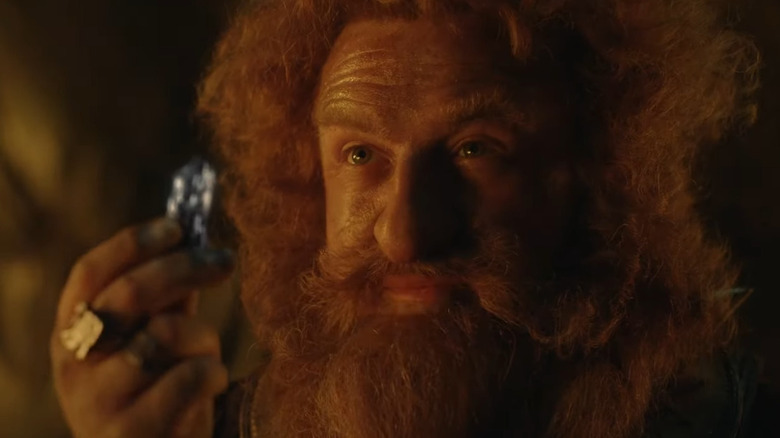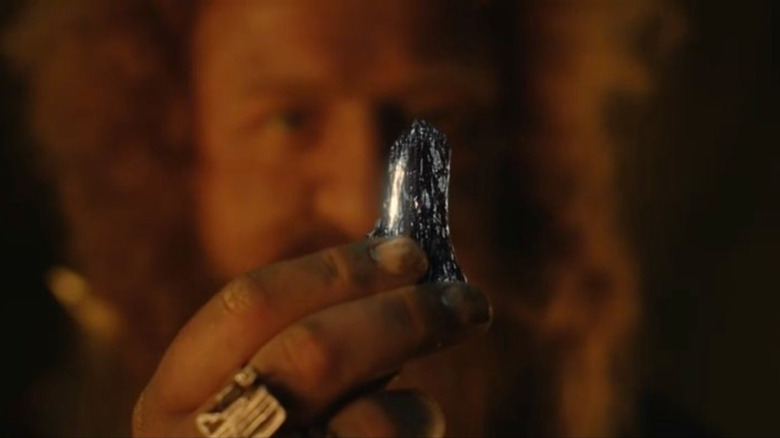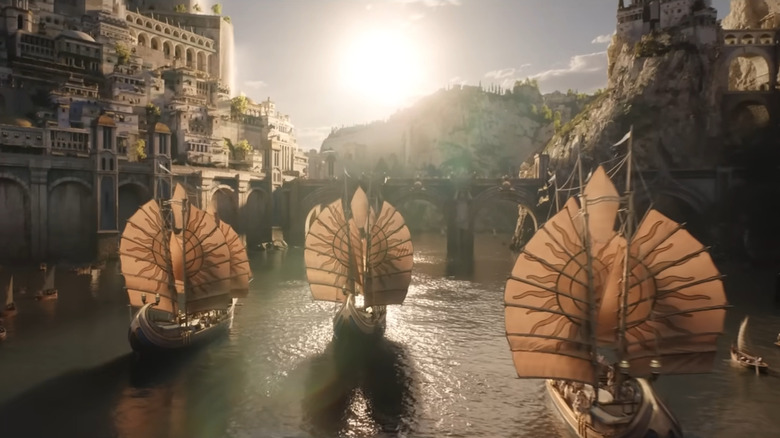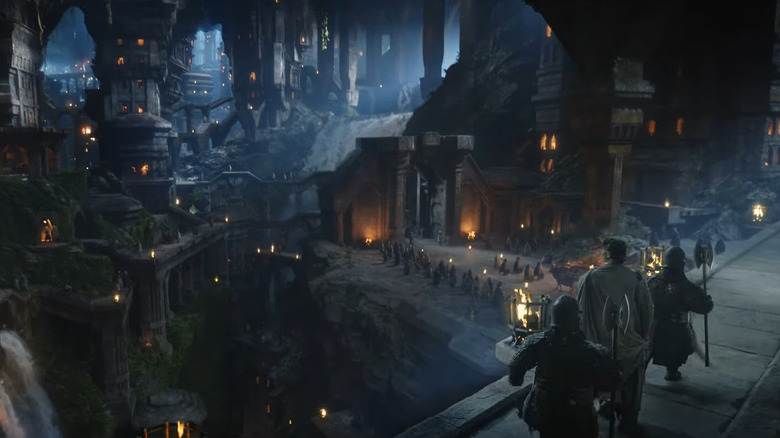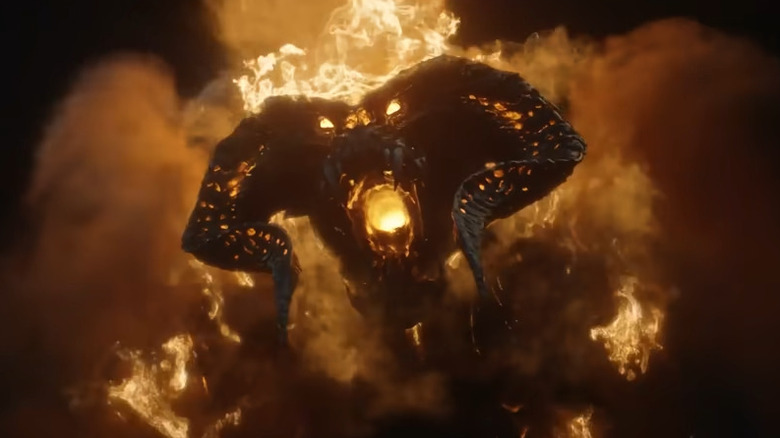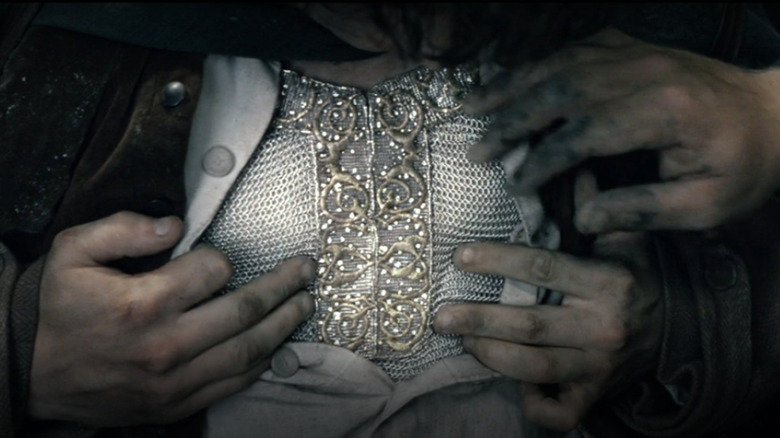The Rings Of Power's Mithril Is More Important To Middle-Earth Than You Likely Realize
Contains spoilers for "The Lord of the Rings: The Rings of Power" Season 1, Episode 4 — "The Great Wave"
"The Lord of the Rings: The Rings of Power" Episode 4 moves a lot of stories forward at the same time. In the Southlands, we meet Adar (Joseph Mawle) and see Arondir (Ismael Cruz Córdova) reunite with Bronwyn (Nazanin Boniadi) and Theo (Tyroe Muhafidin) just in time for a siege. In Númenor, Isildur (Maxim Baldry) manages to get kicked out of the sea guard, even as his sister settles into her new guild and meets the spoiled royal Kemen (Leon Wadham). To top it off, Queen Regent Míriel (Cynthia Addai-Robinson) steps into her own by declaring to be an Elf-friend and raising an army to help Galadriel (Morfydd Clark) sail to Middle-earth and beat down Sauron.
In spite of all of this action, the episode still spends a ton of time in Khazad-dûm, where Elrond (Robert Aramayo) finally gets to the bottom of his old friend Durin's (Owain Arthur) sneaking and secrecy. After unsuccessfully trying to wheedle information out of Disa (Sophia Nomvete), the Elf uses his superpowered Elvish sight to eavesdrop on his friends. This reveals that Durin is doing something important in an old mine under the Mirrormere. When he visits the mine, Elrond finally discovers what all the clandestine activity is about: Durin has discovered mithril.
The famous metal is featured throughout "The Lord of the Rings" and "The Hobbit" stories, but at that point, it's an extremely rare item that's already been mined. In this case, we're witnessing the genesis of the precious metal's history — and what a history that is. Here's a (relatively quick) breakdown of the many different ways that mithril plays a role in Tolkien's legendarium.
What is mithril?
One of the first times that mithril pops up in detail in Tolkien's writings is when the Fellowship of the Ring passes through the Mines of Moria. In the book by the same name, Gandalf gives the substance three names. Along with the Elvish word "mithril," he also calls it "Moria-silver" and "true-silver." He adds that the Dwarves have a name for it, but they don't tell it to anyone ... which explains why, in "The Lord of the Rings: The Rings of Power" Episode 4, Durin says the Dwarves call it "gray glitter" but doesn't give the specific word in the Dwarvish language of Khuzdul.
In the book, Gandalf goes on to explain what mithril is, saying, "It could be beaten like copper, and polished like glass; and the Dwarves could make of it a metal, light and yet harder than tempered steel. Its beauty was like to that of common silver, but the beauty of mithril did not tarnish or grow dim."
If the description sounds too good to be true, that's because, well, that's pretty much what this miracle ore is. It's everything a smith could want in a metal. The only problem? It's extremely hard to find, and only really shows up in three different places in Tolkien's writings.
Mithril round the world
Most accounts of mithril associate it with the Dwarves of Khazad-dûm. However, there are two other areas, off the shores of Middle-earth, where the precious metal may have also been found — although this can't be definitely stated. In fact, in "The Fellowship of the Ring," Gandalf declares that Moria is the only place in the world where the metal exists. And yet, in the book "Unfinished Tales," Christopher Tolkien includes a note about his father J.R.R. Tolkien's mention of mithril on the island nation of Númenor. Part of the text says, "For that metal was found in Númenor" followed by a description of the Númenórean king Tar-Telemmaitë (which means "silver-handed") ordering his servants to look for mithril. Even here, though, Gandalf's statement is brought up as a complicating factor that makes the metal's existence on the island uncertain.
The other possible location of the metal is in the Blessed Realm away to the West of the Middle-earth map. This is the immortal land where Elrond's father, Eärendil, sails to at the end of the First Age to seek help defeating the Dark Lord Morgoth. In "The Fellowship of the Ring" book, Bilbo writes a song about Eärendil, and in it, he describes the boat that the inhabitants of the Blessed Realm build for the hero to use to sail the skies as a star (it's a whole big thing). The important part here is that one line reads: "A ship then new they built for him of mithril and of elven-glass." Whether the metal is actually mined in Númenor or the Blessed Realm is never stated, but there's no doubt that people have access to mithril overseas, too.
Mithril in Middle-earth
While there are a couple of other places where mithril is mentioned, the only location in Tolkien's world with a solid, tangible source of mithril with a clear backstory is in the Misty Mountains. Specifically, mithril is discovered in the Mines of Khazad-dûm in a single vein that heads north from the subterranean kingdom. This is the definitive source of mithril for nearly every true-silver project, and it's found (and exploited) by the Dwarves to build an incredible fortune during the Second Age of Middle-earth history.
This is the time when "The Lord of the Rings: The Rings of Power" story is set, so the timing of the discovery in the show works. However, one little discrepancy is the existence of Celebrimbor's (Charles Edwards) realm of Eregion. The problem isn't where Eregion is during the show but rather when it is (a necessary side effect of compressing 3,500 years of a story into a short period of time).
The specific reason this is an issue here, though, is because the Elvish kingdom of Eregion is built specifically because of mithril. The appendices of "The Return of the King" say that "Later some of the Noldor went to Eregion, upon the west of the Misty Mountains, and near to the West-gate of Moria. This they did because they learned that mithril had been discovered in Moria." Timing issues aside, the discovery of mithril by the Dwarves is such a big deal that an entire Elvish kingdom pops up next to their home like a Wild West boom town, all because its inhabitants, who are largely craftsmen, want to be close to the only source of true-silver in the world. It's that big of a deal, guys.
Delving too greedily
Not surprisingly, owning the only source of mithril in the world makes the already well-off inhabitants of Khazad-dûm fabulously rich. The Dwarves literally enter a new era — a phrase that the promotional footage for "The Lord of the Rings: The Rings of Power" has used ad-nauseam. If you want to put a number on it, Gandalf reports in "The Fellowship of the Ring" that the metal is already 10 times the worth of gold — and that's when it's still available (more on that in a second).
Toward the end of the Second Age, Númenor suffers its Atlantian fate, an event that also leads to the Blessed Realm being more or less removed from the physical world. The takeaway here is that the other two potential sources of mithril are suddenly gone, making Khazad-dûm's true-silver deposit even more precious. The Dwarves recognize this fact. So what do they do? They keep mining. Some chisel their way up the mountain rock while others go deeper and deeper into the ground. After thousands of years of burrowing, they finally hit a big, fiery roadblock. That's right, they bump into a hibernating Balrog, and that's all she wrote, folks. The demon is disturbed by the commotion, and it attacks the Dwarves, eventually driving the entire population of Khazad-dûm out of their ancestral home.
The world is thus cut off from its sole mithril deposit, sending the market price through the roof. This is what leads Gandalf to later declare about Bilbo's mithril corslet, "I never told him, but its worth was greater than the value of the whole Shire and everything in it."
Mithril's role in the Third Age
The "Lord of the Rings" and "The Hobbit" stories take place roughly a millennium after the Balrog emerges. By that time, mithril has achieved a nearly mythic status, and there are still quite a few famous objects in existence that are made of the miracle metal. Of course, there's Bilbo's corslet, but there's more.
Galadriel's Ring of Power, Nenya, is made of Moria-silver. It's also used in Ithildin, the glowing letters used to write on the secret doors of Moria. The guards of Minas Tirith have mithril incorporated into their helmets, which are referred to as "heirlooms from the glory of old days" in "The Return of the King" book. In the printed version of the story, it also says that one of Aragorn's ancient family heirlooms called the Star of Elendil is set in a mithril fillet. Arwen makes a banner for her future husband with mithril woven into the image, as well. After the War of the Ring, Gimli even returns to Minas Tirith, where he rebuilds the gates using a combination of mithril and steel. The last place where mithril can be found in "The Lord of the Rings" is in the Land of Shadow itself. In "The Fellowship of the Ring," Gandalf explains the fate of the mithril left behind when the Dwarves vacate Moria, saying that "Of what they brought to light the Orcs have gathered nearly all, and given it in tribute to Sauron, who covets it."
From gates to armor, rings to banners, Balrogs to the Dark Lord's coffers, mithril plays a critical role throughout Middle-earth history. From what we've seen, it's going to impact "The Lord of the Rings: The Rings of Power" story both for better and very much so for worse.
